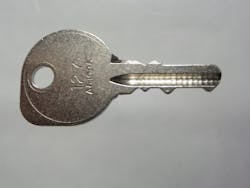Back Page, December 2020
Twenty Years Ago
ABUS padlock servicing was the subject of an article. Experinetix interchangable-core lock systems and its round, hockey puck locks also were discussed. Jerry Levine continued his article on upgrading a double-door opening that has continuous hinges, a removable mullion, exit devices and door closers. Tiny tackled a 2000 Dodge Ram pickup and showed how to service the locks. Jerry Levine reported on three new drawer locks from Olympus Lock. Dennis Baxter used his tryout key system while fitting keys to a 2000 Chevrolet Cavalier. Tony Vigil, High Tech Tools, showed how to unlock a 2000 Ford Focus. John Grist visited the Wilson Bohannan factory and provided history on this 100-year-old company. Dave Franchuk opened an old Victor double-door safe, while Milt Wolfersder reviewed a Mosler insulated file cabinet.
Ten Years Ago
Jerry Levine demonstrated how to clone vehicles while using a Bianchi 884 Decryptor Ultegra. JMA wrote an article on its key-blank numbering system for automotive keys. Tim O’Leary explained how to adhere to building codes when installing door alarms. Jerry Levine assisted in the installation of a Norton X-in power door operator. Tim O’Leary offered suggestions for tools and procedures for running wires. Locksmith Edward Brooks reviewed a new cut-depth reader system by AccuReader. Steve Young provided comprehensive instructions for servicing four General Motors models, including the Buick Enclave, Chevrolet Traverse, GMC Acadia and Saturn Outlook. A National Average Price list showed pricing differences between 2000 and 2010. Clark Security provided suggestions for expanding business in the economy of today.
Mercury Boat Ignition
Although not boating season, we have been waiting several months for a back-ordered Mercury ignition switch, and it finally arrived. Mercury boat locks that have codes of 123-134 have been a puzzle for a long time. HPC had silhouettes of the keys in an old code book, but the spacings varied from code to code.
The mystery has been solved. Most cuts on the keys aren’t necessary. There are three wafers stacked together in each lock. Each wafer is 0.050 inches thick. “Vee” cuts are used and the 45-degree bevels are wider than 0.050 inches. Cuts overflow into adjacent wafer spaces, so only a small amount of metal is left to lift each tumbler. This is probably the worst lock design we ever have seen. In this case, the mystery is solved, but it’s best to continue obtaining precut keys.
